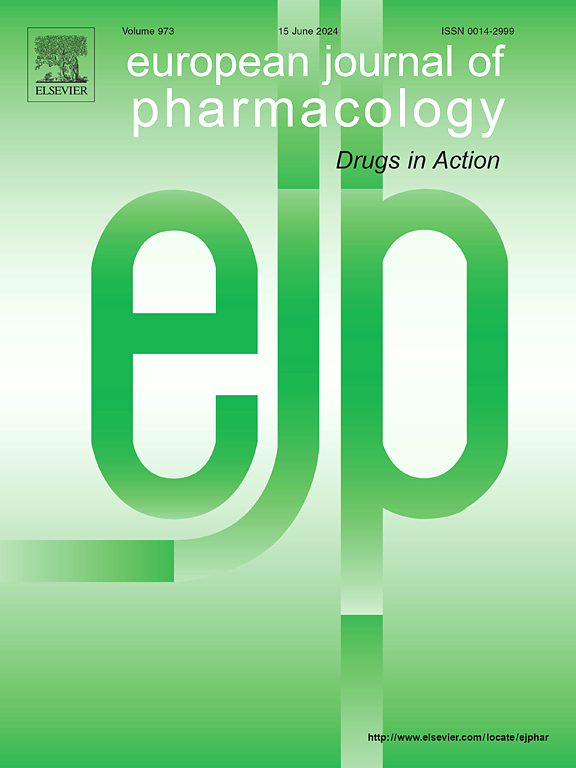Oleocanthalic acid improves MASH features via a NOX1-dependent mechanism
IF 4.2
3区 医学
Q1 PHARMACOLOGY & PHARMACY
引用次数: 0
Abstract
Metabolic dysfunction-associated steatohepatitis (MASH) is a chronic liver disease with increasing incidence. This study aimed at assessing the beneficial effects of oleocanthalic acid (OcA), extracted from extra virgin olive oil, in cellular models of MASH. OcA effects on lipid accumulation, oxidative stress, inflammation, and fibrosis were evaluated on 2D HepG2 cells treated with a palmitic and oleic acid mixture (1:2 0.1 mM) to induce steatosis, HepG2 co-cultured with THP-1-derived M1-like macrophages, multicellular spheroids (MCS) composed of HepG2 and TGFβ1-activated LX-2 cells co-cultured with macrophages, and spheroids of 3T3-L1-derived adipocytes. OcA effect was assessed by evaluating lipid droplets after Bodipy stain, reactive oxygen species (ROS), and mRNA expression by qPCR. The expression of the fibrogenic marker α-smooth muscle actin (Acta2) was assessed by ICC. OcA interaction with the pro-oxidant NADPH oxidases NOX1 and NOX4 was investigated via molecular docking simulations. OcA reduced the size and number of lipid droplets and ROS in HepG2 cells. In the MCS model, besides reducing lipid accumulation, OcA promoted a switch in macrophages towards an anti-inflammatory phenotype. OcA decreased Acta2 expression in activated LX-2 cells and prevented the LX-2 cell activation induced by the secretome of 3T3-L1-derived adipocyte spheroids. Molecular docking simulations suggested that OcA could act as a selective NOX1 inhibitor, binding to NOX1 in close contact with the FAD molecule. In conclusion, OcA demonstrated promising anti-steatotic, anti-inflammatory, and anti-fibrotic effects in different in vitro models of MASH, thus representing a potential therapeutic option for preventing lipid accumulation and fibrogenesis in MASH, with a NOX1-dependend mechanism of action.
油酸通过nox1依赖机制改善MASH特征。
代谢功能障碍相关脂肪性肝炎(MASH)是一种发病率越来越高的慢性肝脏疾病。本研究旨在评估从特级初榨橄榄油中提取的油酸(OcA)对MASH细胞模型的有益作用。OcA对脂质积累、氧化应激、炎症和纤维化的影响分别通过棕榈酸和油酸混合物(1:2 0.1 mM)诱导脂肪变性、HepG2与thp -1来源的m1样巨噬细胞共培养、HepG2和tgf - β1激活的LX-2细胞与巨噬细胞共培养组成的多细胞球体(MCS)以及3t3 - l1来源的脂肪细胞球体进行评估。通过Bodipy染色后的脂滴、活性氧(ROS)和qPCR的mRNA表达来评估OcA的效果。采用ICC法检测成纤维标志物α-平滑肌肌动蛋白(Acta2)的表达。通过分子对接模拟研究了OcA与促氧化NADPH氧化酶NOX1和NOX4的相互作用。OcA可降低HepG2细胞的脂滴大小和ROS数量。在MCS模型中,OcA除了减少脂质积累外,还促进巨噬细胞向抗炎表型转变。OcA降低活化的LX-2细胞中Acta2的表达,阻止3t3 - l1来源的脂肪细胞球体分泌组诱导的LX-2细胞活化。分子对接模拟表明,OcA可以作为一种选择性的NOX1抑制剂,与FAD分子紧密接触,与NOX1结合。综上所述,OcA在不同的MASH体外模型中显示出良好的抗脂肪变性、抗炎和抗纤维化作用,因此代表了一种潜在的治疗选择,可以防止MASH中的脂质积累和纤维形成,其作用机制依赖于nox1。
本文章由计算机程序翻译,如有差异,请以英文原文为准。
求助全文
约1分钟内获得全文
求助全文
来源期刊
CiteScore
9.00
自引率
0.00%
发文量
572
审稿时长
34 days
期刊介绍:
The European Journal of Pharmacology publishes research papers covering all aspects of experimental pharmacology with focus on the mechanism of action of structurally identified compounds affecting biological systems.
The scope includes:
Behavioural pharmacology
Neuropharmacology and analgesia
Cardiovascular pharmacology
Pulmonary, gastrointestinal and urogenital pharmacology
Endocrine pharmacology
Immunopharmacology and inflammation
Molecular and cellular pharmacology
Regenerative pharmacology
Biologicals and biotherapeutics
Translational pharmacology
Nutriceutical pharmacology.

 求助内容:
求助内容: 应助结果提醒方式:
应助结果提醒方式:


